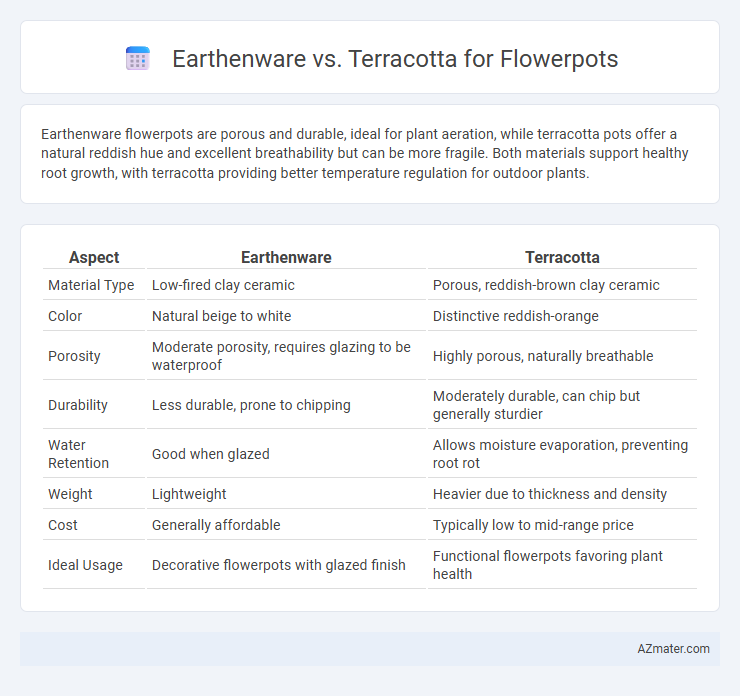Earthenware flowerpots are porous and durable, ideal for plant aeration, while terracotta pots offer a natural reddish hue and excellent breathability but can be more fragile. Both materials support healthy root growth, with terracotta providing better temperature regulation for outdoor plants.
Table of Comparison
| Aspect | Earthenware | Terracotta |
|---|---|---|
| Material Type | Low-fired clay ceramic | Porous, reddish-brown clay ceramic |
| Color | Natural beige to white | Distinctive reddish-orange |
| Porosity | Moderate porosity, requires glazing to be waterproof | Highly porous, naturally breathable |
| Durability | Less durable, prone to chipping | Moderately durable, can chip but generally sturdier |
| Water Retention | Good when glazed | Allows moisture evaporation, preventing root rot |
| Weight | Lightweight | Heavier due to thickness and density |
| Cost | Generally affordable | Typically low to mid-range price |
| Ideal Usage | Decorative flowerpots with glazed finish | Functional flowerpots favoring plant health |
Introduction to Earthenware and Terracotta Flowerpots
Earthenware flowerpots are crafted from porous clay that is fired at lower temperatures, making them lightweight and ideal for plants needing good airflow and drainage. Terracotta flowerpots, a subtype of earthenware, feature a distinctive reddish-brown color due to iron oxide in the clay and offer excellent breathability, which helps prevent root rot and overwatering. Both materials enhance plant health by allowing moisture evaporation, but terracotta pots are generally more dense and durable compared to standard earthenware.
Composition and Material Differences
Earthenware flowerpots are typically made from a mixture of clay, sand, and other natural materials, resulting in a porous and relatively soft ceramic that retains moisture well but is prone to chipping. Terracotta pots consist primarily of natural, unglazed clay fired at lower temperatures, which gives them their characteristic reddish color and excellent breathability for plant roots. The key material difference lies in terracotta's higher iron content and porous texture, whereas earthenware may include additional minerals and glazes that affect durability and water retention.
Manufacturing Processes Compared
Earthenware flowerpots are typically manufactured by firing clay at lower temperatures between 1,000degC and 1,150degC, resulting in a porous and less dense material that requires glazing for water retention. Terracotta pots undergo a similar low-fired process but often use red or orange clay rich in iron oxide, giving them their characteristic warm hue and slightly more durable finish. Both manufacturing processes emphasize hand molding or slip casting techniques, but terracotta's natural composition often leads to enhanced breathability and evaporation properties ideal for plant growth.
Appearance and Texture Variations
Earthenware flowerpots typically feature a smooth, glazed surface with diverse color options, offering a polished appearance that enhances plant presentation. Terracotta pots display a characteristic rustic, reddish-brown hue with a porous, matte texture that allows for better air and moisture exchange. Variations in texture between glazed earthenware and unglazed terracotta influence both aesthetic appeal and plant health.
Porosity and Water Retention Capabilities
Earthenware flowerpots exhibit higher porosity compared to terracotta, allowing for better air circulation and moisture evaporation which prevents root rot. Terracotta, while still porous, tends to retain more water due to its denser composition, providing a more consistent moisture level for plants. The choice between earthenware and terracotta directly impacts water retention capabilities, influencing plant health based on specific watering needs.
Durability and Longevity Factors
Earthenware flowerpots are typically glazed, offering moderate durability but are prone to cracking under extreme weather conditions, limiting their longevity. Terracotta pots, made from fired clay, are porous and allow air and moisture to penetrate, which benefits plant roots but can lead to chipping and breakage over time. For long-lasting flowerpots, terracotta provides natural breathability and aesthetic appeal, while earthenware offers more resistance to water absorption but may require careful handling to avoid damage.
Ideal Plant Types for Each Material
Earthenware flowerpots are ideal for moisture-loving plants like ferns and peace lilies due to their porous nature, which allows better air and water circulation. Terracotta pots suit drought-tolerant plants such as succulents and cacti, as their porous composition helps wick away excess moisture, preventing root rot. Both materials provide breathability for roots but require different watering approaches aligned with the plant's moisture needs.
Cost and Availability Analysis
Earthenware flowerpots generally offer a lower cost compared to terracotta due to their mass production and use of varied clay compositions, making them more accessible to budget-conscious gardeners. Terracotta pots, while slightly more expensive, are widely available and favored for their natural porous properties that aid plant health through better aeration and moisture regulation. Both materials are commonly found in garden centers and online markets, but the choice between them often hinges on balancing upfront cost with long-term gardening benefits.
Environmental Impact and Sustainability
Earthenware flowerpots, made from natural clay fired at lower temperatures, tend to have a smaller carbon footprint compared to terracotta, which requires higher firing temperatures, increasing energy consumption. Both materials are biodegradable and recyclable, but terracotta's durability often results in longer-lasting pots, reducing waste over time. Choosing locally sourced clay for either type further minimizes transportation emissions, enhancing overall environmental sustainability.
Choosing the Right Flowerpot for Your Garden
Earthenware and terracotta flowerpots both offer excellent breathability and natural insulation for plant roots, but terracotta is more porous, promoting better aeration and moisture evaporation. Earthenware pots often feature a glazed finish that retains moisture longer, making them ideal for plants needing consistent hydration in dry climates. When choosing the right flowerpot for your garden, consider terracotta for drought-tolerant plants and earthenware for moisture-loving species to optimize growth and health.

Infographic: Earthenware vs Terracotta for Flowerpot
 azmater.com
azmater.com